| Revision as of 18:18, 14 October 2010 view sourceRichard New Forest (talk | contribs)Autopatrolled, Extended confirmed users10,207 edits Undid revision 390723663 by 69.19.14.25 (talk) Revert: blatant copyvio; also source does not give its source and info directly conflicts with other refs.← Previous edit | Revision as of 15:49, 20 October 2010 view source 64.72.66.74 (talk)No edit summaryTag: shoutingNext edit → | ||
| Line 1: | Line 1: | ||
| JAGUARS ARE SO COOL!!!! | |||
| {{Other uses}} | {{Other uses}} | ||
| {{Taxobox | {{Taxobox | ||
Revision as of 15:49, 20 October 2010
JAGUARS ARE SO COOL!!!!
For other uses, see Jaguar (disambiguation).
| Jaguar | |
|---|---|
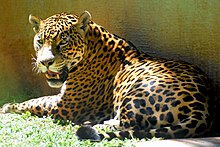
| |
| Conservation status | |
 Near Threatened (IUCN 3.1) | |
| Scientific classification | |
| Kingdom: | Animalia |
| Phylum: | Chordata |
| Class: | Mammalia |
| Order: | Carnivora |
| Family: | Felidae |
| Genus: | Panthera |
| Species: | P. onca |
| Binomial name | |
| Panthera onca Linnaeus, 1758 | |
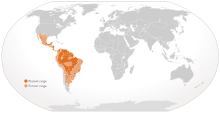
| |
| Jaguar range | |
The jaguar (Panthera onca) is a big cat, a feline in the Panthera genus, and is the only Panthera species found in the Americas. The jaguar is the third-largest feline after the tiger and the lion, and the largest and most powerful feline in the Western Hemisphere. The jaguar's present range extends from Mexico across much of Central America and south to Paraguay and northern Argentina. Apart from a known and possibly breeding population in Arizona (southeast of Tucson), the cat has largely been extirpated from the United States since the early 1900s.
This spotted cat most closely resembles the leopard physically, although it is usually larger and of sturdier build and its behavioral and habitat characteristics are closer to those of the tiger. While dense rainforest is its preferred habitat, the jaguar will range across a variety of forested and open terrain. It is strongly associated with the presence of water and is notable, along with the tiger, as a feline that enjoys swimming. The jaguar is a largely solitary, stalk-and-ambush predator, and is opportunistic in prey selection. It is also an apex and keystone predator, playing an important role in stabilizing ecosystems and regulating the populations of prey species. The jaguar has an exceptionally powerful bite, even relative to the other big cats. This allows it to pierce the shells of armoured reptiles and to employ an unusual killing method: it bites directly through the skull of prey between the ears to deliver a fatal bite to the brain.
The jaguar is a near threatened species and its numbers are declining. Threats include habitat loss and fragmentation. While international trade in jaguars or their parts is prohibited, the cat is still regularly killed by humans, particularly in conflicts with ranchers and farmers in South America. Although reduced, its range remains large; given its historical distribution, the jaguar has featured prominently in the mythology of numerous indigenous American cultures, including that of the Maya and Aztec.
Etymology

The word jaguar is Template:Pron-en or, in British English, /ˈdʒæɡjuː.ər/. It comes to English from one of the Tupi-Guarani languages, presumably the Amazonian trade language Tupinambá, via Portuguese jaguar. The Tupian word, yaguara "beast", sometimes translated as "dog", is used for any carnivorous mammal. The specific word for jaguar is yaguareté, with the suffix -eté meaning "real" or "true".
The first component of its taxonomic designation, Panthera, is Latin, from the Greek word for leopard, πάνθηρ, the type species for the genus. This has been said to derive from the παν- "all" and θήρ from θηρευτής "predator", meaning "predator of all" (animals), though this may be a folk etymology—it may instead be ultimately of Sanskrit origin, from pundarikam, the Sanskrit word for "tiger".
Onca is the Portuguese onça, with the cedilla dropped for typographical reasons, found in English as ounce for the Snow Leopard, Uncia uncia. It derives from the Latin lyncea lynx, with the letter L confused with the definite article (Italian lonza, Old French l'once).
In many Central and South American countries, the cat is referred to as el tigre ("the tiger").
Taxonomy
The jaguar, Panthera onca, is the only extant New World member of the Panthera genus. DNA evidence shows that the lion, tiger, leopard, jaguar, snow leopard, and clouded leopard share a common ancestor and that this group is between six and ten million years old; the fossil record points to the emergence of Panthera just two to 3.8 million years ago. Phylogenetic studies generally have shown that the clouded leopard (Neofelis nebulosa) is basal to this group. The position of the remaining species varies between studies and is effectively unresolved.
Based on morphological evidence, British zoologist Reginald Pocock concluded that the jaguar is most closely related to the leopard. However, DNA evidence is inconclusive and the position of the jaguar relative to the other species varies between studies. Fossils of extinct Panthera species, such as the European Jaguar (Panthera gombaszoegensis) and the American Lion (Panthera atrox), show characteristics of both the lion and the jaguar. Analysis of jaguar mitochondrial DNA has dated the species lineage to between 280,000 and 510,000 years ago, later than suggested by fossil records.
Geographical variation

The last taxonomic delineation of the jaguar subspecies was performed by Pocock in 1939. Based on geographic origins and skull morphology, he recognized eight subspecies. However, he did not have access to sufficient specimens to critically evaluate all subspecies, and he expressed doubt about the status of several. Later consideration of his work suggested only three subspecies should be recognized.
Recent studies have also failed to find evidence for well defined subspecies, and are no longer recognized. Larson (1997) studied the morphological variation in the jaguar and showed that there is clinal north–south variation, but also that the differentiation within the supposed subspecies is larger than that between them and thus does not warrant subspecies subdivision. A genetic study by Eizirik and coworkers in 2001 confirmed the absence of a clear geographical subspecies structure, although they found that major geographical barriers such as the Amazon River limited the exchange of genes between the different populations. A subsequent, more detailed, study confirmed the predicted population structure within the Colombian jaguars.
Pocock's subspecies divisions are still regularly listed in general descriptions of the cat. Seymour grouped these in three subspecies.
- Panthera onca onca: Venezuela through the Amazon, including
- P. onca peruviana (Peruvian Jaguar): Coastal Peru
- P. onca hernandesii (Mexican Jaguar): Western Mexico – including
- P. onca centralis (Central American Jaguar): El Salvador to Colombia
- P. onca arizonensis (Arizonan Jaguar): Southern Arizona to Sonora, Mexico
- P. onca veraecrucis: Central Texas to Southeastern Mexico
- P. onca goldmani (Goldman's Jaguar): Yucatán Peninsula to Belize and Guatemala
- P. onca palustris (the largest subspecies, weighing more than 135 kg or 300 lb): The Pantanal regions of Mato Grosso & Mato Grosso do Sul, Brazil, along the Paraguay River into Paraguay and northeastern Argentina.
The Mammal Species of the World continues to recognize nine subspecies, the eight subspecies above and additionally P. o. paraguensis.
Biology and behavior
Physical characteristics
The jaguar is a compact and well-muscled animal. There are significant variations in size and weight: weights are normally in the range of 56–96 kilograms (124–211 lb). Larger males have been recorded at 160 kilograms (350 lb) (roughly matching a tigress or lioness), and smaller ones have extremely low weights of 36 kilograms (80 lb). Females are typically 10–20% smaller than males. The length of the cat varies from 1.62–1.83 metres (5.3–6 ft), and its tail may add a further 75 centimeters (30 in). It stands about 67–76 centimeters (27–30 in) tall at the shoulders.
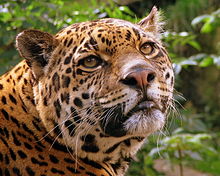
Further variations in size have been observed across regions and habitats, with size tending to increase from the north to south. A study of the jaguar in the Chamela-Cuixmala Biosphere Reserve on the Mexican Pacific coast, showed ranges of just 30–50 kilograms (66–110 lb), about the size of the cougar. By contrast, a study of the Jaguar in the Brazilian Pantanal region found average weights of 100 kilograms (220 lb) and weights of 300 lb or more are not uncommon in old males. Forest jaguars are frequently darker and considerably smaller than those found in open areas (the Pantanal is an open wetland basin), possibly due to the smaller numbers of large herbivorous prey in forest areas.
A short and stocky limb structure makes the jaguar adept at climbing, crawling and swimming. The head is robust and the jaw extremely powerful. It has been suggested that the jaguar has the strongest bite of all felids capable of biting down with 2000 lbs of force twice the strength of a lion, and the second strongest of all mammals after the spotted hyena; this strength is an adaptation that allows the jaguar to pierce turtle shells. A comparative study of bite force adjusted for body size ranked it as the top felid, alongside the clouded leopard and ahead of the lion and tiger. It has been reported that "an individual jaguar can drag a 360 kg (800 lb) bull 8 m (25 ft) in its jaws and pulverize the heaviest bones". The jaguar hunts wild animals weighing up to 300 kilograms (660 lb) in dense jungle, and its short and sturdy physique is thus an adaptation to its prey and environment.
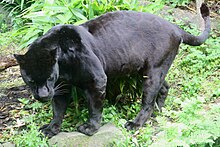
The base coat of the jaguar is generally a tawny yellow, but can range to reddish-brown and black. The cat is covered in rosettes for camouflage in its jungle habitat. The spots vary over individual coats and between individual Jaguars: rosettes may include one or several dots, and the shape of the dots varies. The spots on the head and neck are generally solid, as are those on the tail, where they may merge to form a band. The underbelly, throat and outer surface of the legs and lower flanks are white.
A condition known as melanism occurs in the species. The melanistic form is less common than the spotted form (it occurs at about six percent of the population) of jaguars and is the result of a dominant allele. Jaguars with melanism appear entirely black, although their spots are still visible on close examination. Melanistic Jaguars are informally known as black panthers, but do not form a separate species. Rare albino individuals, sometimes called white panthers, also occur among jaguars, as with the other big cats.
While the jaguar closely resembles the leopard, it is sturdier and heavier, and the two animals can be distinguished by their rosettes: the rosettes on a jaguar's coat are larger, fewer in number, usually darker, and have thicker lines and small spots in the middle that the leopard lacks. Jaguars also have rounder heads and shorter, stockier limbs compared to leopards.
Reproduction and life cycle
Jaguar females reach sexual maturity at about two years of age, and males at three or four. The cat is believed to mate throughout the year in the wild, although births may increase when prey is plentiful. Research on captive male jaguars supports the year-round mating hypothesis, with no seasonal variation in semen traits and ejaculatory quality; low reproductive success has also been observed in captivity. Female estrous is 6–17 days out of a full 37-day cycle, and females will advertise fertility with urinary scent marks and increased vocalization. Both sexes will range more widely than usual during courtship.

Mating pairs separate after the act, and females provide all parenting. The gestation period lasts 93–105 days; females give birth to up to four cubs, and most commonly to two. The mother will not tolerate the presence of males after the birth of cubs, given a risk of infanticide; this behaviour is also found in the tiger.
The young are born blind, gaining sight after two weeks. Cubs are weaned at three months but remain in the birth den for six months before leaving to accompany their mother on hunts. They will continue in their mother's company for one to two years before leaving to establish a territory for themselves. Young males are at first nomadic, jostling with their older counterparts until they succeed in claiming a territory. Typical lifespan in the wild is estimated at around 12–15 years; in captivity, the jaguar lives up to 23 years, placing it among the longest-lived cats.
Social activity
Like most cats, the jaguar is solitary outside mother-cub groups. Adults generally meet only to court and mate (though limited non-courting socialization has been observed anecdotally) and carve out large territories for themselves. Female territories, which range from 25 to 40 square kilometers in size, may overlap, but the animals generally avoid one another. Male ranges cover roughly twice as much area, varying in size with the availability of game and space, and do not overlap. The jaguar uses scrape marks, urine, and feces to mark its territory.
Like the other big cats, the jaguar is capable of roaring (the male more powerfully) and does so to warn territorial and mating competitors away; intensive bouts of counter-calling between individuals have been observed in the wild. Their roar often resembles a repetitive cough, and they may also vocalize mews and grunts. Mating fights between males occur, but are rare, and aggression avoidance behaviour has been observed in the wild. When it occurs, conflict is typically over territory: a male's range may encompass that of two or three females, and he will not tolerate intrusions by other adult males.
The jaguar is often described as nocturnal, but is more specifically crepuscular (peak activity around dawn and dusk). Both sexes hunt, but males travel further each day than females, befitting their larger territories. The jaguar may hunt during the day if game is available and is a relatively energetic feline, spending as much as 50–60% of its time active. The jaguar's elusive nature and the inaccessibility of much of its preferred habitat make it a difficult animal to sight, let alone study.
Hunting and diet


Like all cats, the jaguar is an obligate carnivore, feeding only on meat. It is an opportunistic hunter and its diet encompasses 87 species. The jaguar prefers large prey and will take deer, capybara, tapirs, peccaries, dogs, foxes, and sometimes even anacondas and caiman. However, the cat will eat any small species that can be caught, including frogs, mice, birds, fish, sloths, monkeys, and turtles; a study conducted in Cockscomb Basin Wildlife Sanctuary in Belize, for example, revealed that jaguars there had a diet that consisted primarily of armadillos and pacas. Some jaguars will also take domestic livestock, including adult cattle and horses.
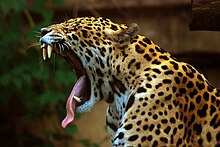
While the jaguar employs the deep-throat bite-and-suffocation technique typical among Panthera, it prefers a killing method unique amongst cats: it pierces directly through the temporal bones of the skull between the ears of prey (especially the Capybara) with its canine teeth, piercing the brain. This may be an adaptation to "cracking open" turtle shells; following the late Pleistocene extinctions, armoured reptiles such as turtles would have formed an abundant prey base for the jaguar. The skull bite is employed with mammals in particular; with reptiles such as caiman, the jaguar may leap on to the back of the prey and sever the cervical vertebrae, immobilizing the target. While capable of cracking turtle shells, the jaguar may simply reach into the shell and scoop out the flesh. With prey such as smaller dogs, a paw swipe to the skull may be sufficient in killing it.
The jaguar is a stalk-and-ambush rather than a chase predator. The cat will walk slowly down forest paths, listening for and stalking prey before rushing or ambushing. The jaguar attacks from cover and usually from a target's blind spot with a quick pounce; the species' ambushing abilities are considered nearly peerless in the animal kingdom by both indigenous people and field researchers, and are probably a product of its role as an apex predator in several different environments. The ambush may include leaping into water after prey, as a jaguar is quite capable of carrying a large kill while swimming; its strength is such that carcasses as large as a heifer can be hauled up a tree to avoid flood levels.
On killing prey, the jaguar will drag the carcass to a thicket or other secluded spot. It begins eating at the neck and chest, rather than the midsection. The heart and lungs are consumed, followed by the shoulders. The daily food requirement of a 34 kilogram animal, at the extreme low end of the species' weight range, has been estimated at 1.4 kilograms. For captive animals in the 50–60 kilogram range, more than 2 kilograms of meat daily is recommended. In the wild, consumption is naturally more erratic; wild cats expend considerable energy in the capture and kill of prey, and may consume up to 25 kilograms of meat at one feeding, followed by periods of famine. Unlike all other species in the Panthera genus, jaguars very rarely attack humans. Most of the scant cases where jaguars turn to taking a human show that the animal is either old with damaged teeth or is wounded. Sometimes, if scared, jaguars in captivity may lash out at zookeepers.
Ecology
Distribution and habitat
The jaguar has been attested in the fossil record for two million years and it has been an American cat since crossing the Bering Land Bridge during the Pleistocene epoch; the immediate ancestor of modern animals is Panthera onca augusta, which was larger than the contemporary cat. Its present range extends from Mexico, through Central America and into South America, including much of Amazonian Brazil. The countries included in this range are Argentina, Belize, Bolivia, Brazil, Colombia, Costa Rica (particularly on the Osa Peninsula), Ecuador, French Guiana, Guatemala, Guyana, Honduras, Mexico, Nicaragua, Panama, Paraguay, Peru, Suriname, United States and Venezuela. The jaguar is now extinct in El Salvador and Uruguay. It occurs in the 400 km² Cockscomb Basin Wildlife Sanctuary in Belize, the 5,300 km² Sian Ka'an Biosphere Reserve in Mexico, the approximately 15,000 km² Manú National Park in Peru, the approximately 26,000 km² Xingu National Park in Brazil, and numerous other reserves throughout its range.

The inclusion of the United States in the list is based on occasional sightings in the southwest, particularly in Arizona, New Mexico and Texas. In the early 1900s, the jaguar's range extended as far north as the Grand Canyon, and as far west as Southern California. The jaguar is a protected species in the United States under the Endangered Species Act, which has stopped the shooting of the animal for its pelt. In 2004, wildlife officials in Arizona photographed and documented jaguars in the southern part of the state. For any permanent population to thrive, protection from killing, an adequate prey base, and connectivity with Mexican populations are essential. On February 25, 2009 a 118 lb Jaguar was caught, radio-collared and released in an area southwest of Tucson, Arizona; this is farther north than had previously been expected and represents a sign that there may be a permanent breeding population of Jaguars within southern Arizona. It was later confirmed that the animal is indeed the same male individual (known as 'Macho B') that was photographed in 2004 and is now the oldest known Jaguar in the wild (approximately 15 years old.) On Monday March 2, 2009, Macho B, which is the only jaguar spotted in the U.S. in more than a decade, was recaptured and euthanized after he was found to be suffering from kidney failure.
Completion of the United States–Mexico barrier as currently proposed will reduce the viability of any population currently residing in the United States, by reducing gene flow with Mexican populations, and prevent any further northward expansion for the species.
The historic range of the species included much of the southern half of the United States, and in the south extended much farther to cover most of the South American continent. In total, its northern range has receded 1000 kilometers southward and its southern range 2000 km northward. Ice age fossils of the jaguar, dated between 40,000 and 11,500 years ago, have been discovered in the United States, including some at an important site as far north as Missouri. Fossil evidence shows jaguars of up to 190 kg (420 lb), much larger than the contemporary average for the animal.
The habitat of the cat includes the rain forests of South and Central America, open, seasonally flooded wetlands, and dry grassland terrain. Of these habitats, the jaguar much prefers dense forest; the cat has lost range most rapidly in regions of drier habitat, such as the Argentinian pampas, the arid grasslands of Mexico, and the southwestern United States. The cat will range across tropical, subtropical, and dry deciduous forests (including, historically, oak forests in the United States). The jaguar is strongly associated with water and it often prefers to live by rivers, swamps, and in dense rainforest with thick cover for stalking prey. Jaguars have been found at elevations as high as 3800 m, but they typically avoid montane forest and are not found in the high plateau of central Mexico or in the Andes.
Substantial evidence exists that there is also a colony of non-native melanistic leopards or jaguars inhabiting the rainforests around Sydney, Australia. A local report compiled statements from over 450 individuals recounting their stories of sighting large black cats in the area and confidential NSW Government documents regarding the matter proved wildlife authorities were so concerned about the big cats and the danger to humans, they commissioned an expert to catch it. The three-day hunt later failed, but ecologist Johannes J. Bauer warned: "Difficult as it seems to accept, the most likely explanation is the presence of a large, feline predator. In this area, most likely a leopard, less likely a jaguar."
Ecological role
The adult jaguar is an apex predator, meaning that it exists at the top of its food chain and is not preyed on in the wild. The jaguar has also been termed a keystone species, as it is assumed, through controlling the population levels of prey such as herbivorous and granivorous mammals, apex felids maintain the structural integrity of forest systems. However, accurately determining what effect species like the jaguar have on ecosystems is difficult, because data must be compared from regions where the species is absent as well as its current habitats, while controlling for the effects of human activity. It is accepted that mid-sized prey species undergo population increases in the absence of the keystone predators and it has been hypothesized that this has cascading negative effects. However, field work has shown this may be natural variability and that the population increases may not be sustained. Thus, the keystone predator hypothesis is not favoured by all scientists.
The jaguar also has an effect on other predators. The jaguar and the cougar, the next largest feline of the Americas, are often sympatric (related species sharing overlapping territory) and have often been studied in conjunction. Where sympatric with the jaguar, the cougar is smaller than normal and is smaller than the local jaguars. The jaguar tends to take larger prey and the cougar smaller, reducing the latter's size. This situation may be advantageous to the cougar. Its broader prey niche, including its ability to take smaller prey, may give it an advantage over the jaguar in human-altered landscapes; while both are classified as near-threatened species, the cougar has a significantly larger current distribution.
Conservation status

Jaguar populations are rapidly declining. The animal is considered Near Threatened by the International Union for Conservation of Nature and Natural Resources, meaning it may be threatened with extinction in the near future. The loss of parts of its range, including its virtual elimination from its historic northern areas and the increasing fragmentation of the remaining range, have contributed to this status. The 1960s saw particularly significant declines, with more than 15,000 jaguar skins brought out of the Brazilian Amazon yearly; the Convention on International Trade in Endangered Species (CITES) of 1973 brought about a sharp decline in the pelt trade. Detailed work performed under the auspices of the Wildlife Conservation Society reveal that the animal has lost 37% of its historic range, with its status unknown in an additional 18%. More encouragingly, the probability of long-term survival was considered high in 70% of its remaining range, particularly in the Amazon basin and the adjoining Gran Chaco and Pantanal.
The major risks to the jaguar include deforestation across its habitat, increasing competition for food with human beings, poaching, hurricanes in northern parts of its range, and the behaviour of ranchers who will often kill the cat where it preys on livestock. When adapted to the prey, the jaguar has been shown to take cattle as a large portion of its diet; while land clearance for grazing is a problem for the species, the jaguar population may have increased when cattle were first introduced to South America as the animals took advantage of the new prey base. This willingness to take livestock has induced ranch owners to hire full-time jaguar hunters, and the cat is often shot on sight.
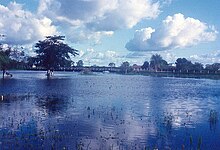
The jaguar is regulated as an Appendix I species under CITES: all international trade in jaguars or their parts is prohibited. All hunting of jaguars is prohibited in Argentina, Belize, Colombia, French Guiana, Honduras, Nicaragua, Panama, Paraguay, Suriname, the United States (where it is listed as endangered under the Endangered Species Act), Uruguay and Venezuela. Hunting of jaguars is restricted to "problem animals" in Brazil, Costa Rica, Guatemala, Mexico and Peru, while trophy hunting is still permitted in Bolivia. The species has no legal protection in Ecuador or Guyana.
Current conservation efforts often focus on educating ranch owners and promoting ecotourism. The jaguar is generally defined as an umbrella species — a species whose home range and habitat requirements are sufficiently broad that, if protected, numerous other species of smaller range will also be protected. Umbrella species serve as "mobile links" at the landscape scale, in the jaguar's case through predation. Conservation organizations may thus focus on providing viable, connected habitat for the jaguar, with the knowledge that other species will also benefit.
Given the inaccessibility of much of the species' range—particularly the central Amazon—estimating jaguar numbers is difficult. Researchers typically focus on particular bioregions, and thus species-wide analysis is scant. In 1991, 600–1,000 (the highest total) were estimated to be living in Belize. A year earlier, 125–180 jaguars were estimated to be living in Mexico's 4,000 square kilometer (2400 mi²) Calakmul Biosphere Reserve, with another 350 in the state of Chiapas. The adjoining Maya Biosphere Reserve in Guatemala, with an area measuring 15,000 square kilometers (9,000 mi²), may have 465–550 animals. Work employing GPS–telemetry in 2003 and 2004 found densities of only six to seven jaguars per 100 square kilometers in the critical Pantanal region, compared with 10 to 11 using traditional methods; this suggests that widely used sampling methods may inflate the actual numbers of cats.
On 7 January 2008 United States Fish and Wildlife Service Director H. Dale Hall approved a decision by the George W. Bush Administration to abandon jaguar recovery as a federal goal under the Endangered Species Act. Some critics of the decision said that the jaguar is being sacrificed for the government's new border fence, which is to be built along many of the cat's typical crossings between the United States and Mexico.
In the past, conservation of jaguars sometimes occurred through the protection of jaguar "hotspots". These hotspots were described as Jaguar Conservation Units, and were large areas populated by about 50 jaguars. However, some researchers recently determined that, in order to maintain a robust sharing of the jaguar gene pool necessary for maintaining the species, it is important that the jaguars be interconnected. To effect this, a new project, the Paseo del Jaguar, as been established to connect the jaguar hotspots.
In mythology and culture
Pre-Columbian Americas
See also: Jaguars in Mesoamerican cultures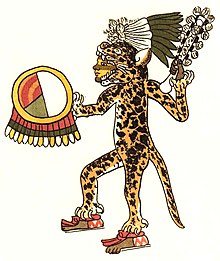

In pre-Columbian Central and South America, the jaguar has long been a symbol of power and strength. Among the Andean cultures, a jaguar cult disseminated by the early Chavín culture became accepted over most of what is today Peru by 900 BC. The later Moche culture of Northern Peru used the jaguar as a symbol of power in many of their ceramics.
In Mesoamerica, the Olmec—an early and influential culture of the Gulf Coast region roughly contemporaneous with the Chavín—developed a distinct "were-jaguar" motif of sculptures and figurines showing stylized jaguars or humans with jaguar characteristics. In the later Maya civilization, the jaguar was believed to facilitate communication between the living and the dead and to protect the royal household. The Maya saw these powerful felines as their companions in the spiritual world, and a number of Maya rulers bore names that incorporated the Mayan word for jaguar (b'alam in many of the Mayan languages). The Aztec civilization shared this image of the jaguar as the representative of the ruler and as a warrior. The Aztecs formed an elite warrior class known as the Jaguar Knights. In Aztec mythology, the jaguar was considered to be the totem animal of the powerful deity Tezcatlipoca.
The jaguar has had importance in Brazil, where the indigenous peoples of Brazil used its fat.
Contemporary culture
The jaguar and its name is widely used as a symbol in contemporary culture. It is the national animal of Guyana, and is featured in its coat of arms. The Flag of the Department of Amazonas, a Colombian department, features a black jaguar silhouette pouncing towards a hunter. The jaguar also appears in banknotes of Brazilian Real
Jaguar is widely used as a product name, most prominently for a luxury car brand. The name has been adopted by sports franchises, including the NFL's Jacksonville Jaguars and the Mexican football club Jaguares de Chiapas. Grammy winning Mexican rock band "Jaguares" were also influenced by the magnificent animal to choose their band name. The crest of Argentina's national federation in rugby union features a jaguar; however, because of a historic accident, the country's national team is nicknamed Los Pumas. The country's "A" (second-level) national team in that sport now bears the Jaguars name.
A melanistic jaguar loose in a South American city is the central figure in the 1942 novel Black Alibi by Cornell Woolrich.
In the spirit of the ancient Mayan culture, the 1968 Olympics in Mexico City adopted a red jaguar as the first official Olympic mascot.
References
- ^ Wozencraft, W. C. (2005). "Order Carnivora". In Wilson, D. E.; Reeder, D. M. (eds.). Mammal Species of the World: A Taxonomic and Geographic Reference (3rd ed.). Johns Hopkins University Press. pp. 546–547. ISBN 978-0-8018-8221-0. OCLC 62265494.
- ^ Template:IUCN2008 Database entry includes justification for why this species is near threatened.
- Stephen Wroe, Colin McHenry, and Jeffrey Thomason (2006). "Bite club: comparative bite force in big biting mammals and the prediction of predatory behavior in fossil taxa" (PDF). Proceedings of the Royal Society B. 272 (1563). Royal Society: 619–625. doi:10.1098/rspb.2004.2986. PMC 1564077. PMID 15817436. Archived from the original (PDF) on September 21, 2006. Retrieved 2006-08-07.
{{cite journal}}: Unknown parameter|deadurl=ignored (|url-status=suggested) (help)CS1 maint: multiple names: authors list (link) - ^ Hamdig, Paul. "Sympatric Jaguar and Puma". Ecology Online Sweden via archive.org. Retrieved 2009-03-19.
- Rosa CL de la and Nocke, 2000. A guide to the carnivores of Central America: natural history, ecology, and conservation. The University of Texas Press. ISBN 978-0-292-71604-9
- ^ "Jaguar". Online Etymology Dictionary. Douglas Harper. Retrieved 2006-08-06.
- "Breve Vocabulario" (in Spanish). Faculty of Law, University of Buenos Aires. Retrieved 2006-09-29.
- Díaz, Eduardo Acevedo (1890). "Notas". Nativas (in Spanish). Retrieved 2006-09-29.
- ^ "Word to the Wise". Take our word for it, issue 198, p. 2. The Institute for Etymological Research and Education. Retrieved 11 August 2006.
- "Yaguareté - La Verdadera Fiera". RED Yaguareté (in Spanish). Retrieved 27 September 2006.
- "panther", Oxford English Dictionary, 2nd edition
- "Panther". Online Etymology Dictionary. Douglas Harper. Retrieved 2006-10-26.
- "ounce" 2, Oxford English Dictionary, 2nd edition
- ^ Johnson, W.E., Eizirik, E., Pecon-Slattery, J., Murphy, W.J., Antunes, A., Teeling, E. & O'Brien, S.J. (2006). "The Late Miocene radiation of modern Felidae: A genetic assessment". Science. 311 (5757): 73–77. doi:10.1126/science.1122277. PMID 16400146.
{{cite journal}}: CS1 maint: multiple names: authors list (link) - Turner, A. (1987). "New fossil carnivore remains from the Sterkfontein hominid site (Mammalia: Carnivora)". Annals of the Transvaal Museum. 34: 319–347. ISSN 0041-1752.
{{cite journal}}: Cite has empty unknown parameters:|month=and|coauthors=(help) - ^ Yu L & Zhang YP (2005). "Phylogenetic studies of pantherine cats (Felidae) based on multiple genes, with novel application of nuclear beta-fibrinogen intron 7 to carnivores". Molecular Phylogenetics and Evolution. 35 (2): 483–495. doi:10.1016/j.ympev.2005.01.017. PMID 15804417.
- ^ Johnson WE & Obrien SJ (1997). "Phylogenetic reconstruction of the Felidae using 16S rRNA and NADH-5 mitochondrial genes". Journal of Molecular Evolution. 44: S098. doi:10.1007/PL00000060.
- ^ Dianne N. Janczewski, William S. Modi, J. Claiborne Stephens, and Stephen J. O'Brien (1 July 1996). "Molecular Evolution of Mitochondrial 12S RNA and Cytochrome b Sequences in the Pantherine Lineage of Felidae". Molecular Biology and Evolution. 12 (4): 690. PMID 7544865. Retrieved 2006-08-06.
{{cite journal}}: CS1 maint: multiple names: authors list (link) - ^ Eizirik E, Kim JH, Menotti-Raymond M, Crawshaw PG Jr, O'Brien SJ, Johnson WE. (2001). "Phylogeography, population history and conservation genetics of jaguars (Panthera onca, Mammalia, Felidae)". Molecular Ecology. 10 (1): 65. doi:10.1046/j.1365-294X.2001.01144.x. PMID 11251788.
{{cite journal}}:|access-date=requires|url=(help)CS1 maint: multiple names: authors list (link) - ^ Seymour, K.L. (1989). "Panthera onca" (PDF). Mammalian Species. 340 (340): 1–9. doi:10.2307/3504096. JSTOR 3504096. Retrieved 2009-12-27.
- Nowak, Ronald M. (1999). Walker's Mammals of the World (6th ed.). Baltimore: Johns Hopkins University Press. ISBN 0-8018-5789-9.
- Larson, Shawn E. (1997). "Taxonomic re-evaluation of the jaguar". Zoo Biology. 16 (2): 107. doi:10.1002/(SICI)1098-2361(1997)16:2<107::AID-ZOO2>3.0.CO;2-E. Retrieved 2006-08-07.
- ^ Ruiz-Garcia M, Payan E, Murillo A & Alvarez D (2006). "DNA microsatellite characterization of the jaguar (Panthera onca) in Colombia" (PDF). Genes & Genetic Systems. 81 (2): 115–127. doi:10.1266/ggs.81.115.
{{cite journal}}: CS1 maint: multiple names: authors list (link) - ^ "Guidelines for Captive Management of Jaguars, Taxonomy, pp. 5–7, Jaguar Species Survival Plan
- "Brazil nature tours, Pantanal nature tours, Brazil tours, Pantanal birding tours, Amazon tours, Iguassu Falls tours, all Brazil tours". Focustours.com. Archived from the original on December 28, 2007. Retrieved 2009-03-08.
{{cite web}}: Unknown parameter|deadurl=ignored (|url-status=suggested) (help) - Burnie, David (2001). Animal: The Definitive Visual Guide to the World's Wildlife. New York City: Dorling Kindersley. ISBN 0-7894-7764-5.
{{cite book}}: Unknown parameter|coauthor=ignored (|author=suggested) (help) - ^ "All about Jaguars: ECOLOGY". Wildlife Conservation Society. Retrieved 2006-08-11.
- ^ Rodrigo Nuanaez, Brian Miller, and Fred Lindzey (2000). "Food habits of jaguars and pumas in Jalisco, Mexico". Journal of Zoology. 252 (3): 373. Retrieved 2006-08-08.
{{cite journal}}: CS1 maint: multiple names: authors list (link) - ^ "Jaguar Fact Sheet" (PDF). Jaguar Species Survival Plan. Retrieved 2006-08-14.
- ^ Nowell, K. and Jackson, P. (compilers and editors) 1996. Wild Cats. Status Survey and Conservation Action Plan (PDF). IUCN/SSC Cat Specialist Group. IUCN, Gland, Switzerland. (see Panthera Onca, pp 118–122)
- "Search for the Jaguar". National Geographic Specials. Alabama Public Television. Retrieved 2006-08-11.
- McGrath, Susan (2004). "Top Cat". National Audubon Society. Retrieved 2009-12-02.
{{cite journal}}: Cite journal requires|journal=(help); Unknown parameter|month=ignored (help) - Dinets, Vladmir. "First documentation of melanism in the jaguar (Panthera onca) from northern Mexico". Retrieved 2006-09-29.
- Meyer, John R. (1994). "Black jaguars in Belize?: A survey of melanism in the jaguar, Panthera onca". Belize Explorer Group. biological-diversity.info.
- "Jaguar (panthera onca)". Our animals. Akron Zoo. Retrieved 2006-08-11.
- ^ "Guidelines", Reproduction, pp. 28–38
- Ronaldo Gonçalves Morato, Marcelo Alcindo Barros de Vaz Guimaraes, Fernando Ferriera, Ieda Terezinha do Nascimento Verreschi, Renato Campanarut Barnabe (1999). "Reproductive characteristics of captive male jaguars". Brazilian Journal of Veterinary Research and Animal Science. 36 (5). doi:10.1590/S1413-95961999000500008. Retrieved 2006-08-08.
{{cite journal}}: CS1 maint: multiple names: authors list (link) - ^ "Guidelines", Natural History & Behavior, pp. 8–16
- "Jaguars: Magnificence in the Southwest" (PDF). Newsletter. Southwest Wildlife Rehabilitation & Educational Foundation. 2006. Retrieved 2009-12-06.
{{cite journal}}: Unknown parameter|month=ignored (help) - George B. Schaller, Peter Gransden Crawshaw, Jr. (1980). "Movement Patterns of Jaguar". Biotropica. 12 (3). Biotropica, Vol. 12, No. 3: 161. doi:10.2307/2387967. Retrieved 2006-08-08.
{{cite journal}}: CS1 maint: multiple names: authors list (link) - ^ Rabinowitz, AR., Nottingham, BG Jr (1986). "Ecology and behaviour of the Jaguar (Panthera onca) in Belize, Central America" (PDF). Journal of Zoology. 210 (1): 149. Retrieved 2009-12-06.
{{cite journal}}: CS1 maint: multiple names: authors list (link) Overlapping male ranges are observed in this study in Belize. Note the overall size of ranges is about half of normal. - ^ Emmons, Louise H. (1987). "Comparative feeding ecology of felids in a neotropical rainforest". Behavioral Ecology and Sociobiology. 20 (4): 271. doi:10.1007/BF00292180. Retrieved 2006-08-08.
- "Jaguar". Kids' Planet. Defenders of Wildlife. Retrieved 2006-09-23.
- "Schaller, G. B. and Vasconselos, J. M. C. (1978). Jaguar predation on capybara. Z. Saugetierk. 43: 296-301" (PDF). Retrieved 2009-10-18.
- ^ "Determination That Designation of Critical Habitat Is Not Prudent for the Jaguar". Federal Register Environmental Documents. 2006-07-12. Retrieved 2006-08-30.
- "Guidelines", Hand-rearing, pp. 62–75 (see table 5)
- "Guidelines", Nutrition, pp. 55–61
- "Jaguar". Catsurvivaltrust.org. 2002-03-09. Retrieved 2009-03-08.
- "Jaguar: The Western Hemisphere's Top Cat". Planeta. Retrieved 2009-03-08.
- ^ Eric W. Sanderson, Kent H. Redford, Cheryl-Lesley B. Chetkiewicz, Rodrigo A. Medellín, Alan R. Rabinowitz, John G. Robinson, and Andrew B. Taber (2002). "Planning to Save a Species: the Jaguar as a Model" (PDF). Conservation Biology. 16 (1): 58. doi:10.1046/j.1523-1739.2002.00352.x. Retrieved 2009-12-11.
{{cite journal}}: CS1 maint: multiple names: authors list (link) Detailed analysis of present range and terrain types provided here. - "Jaguar Management". Arizona Game & Fish,. Retrieved 2006-08-08.
{{cite web}}: CS1 maint: extra punctuation (link) - "Arizona Game and Fish collars first wild jaguar in United States". Readitnews.com. Retrieved 2009-03-08.
- Hock, Heather (2009-03-02). "Illness forced vets to euthuanize recaptured jaguar". Azcentral.com. Retrieved 2009-03-08.
- "Addressing the Impacts of Border Security Activities On Wildlife and Habitat in Southern Arizona: STAKEHOLDER RECOMMENDATIONS" (PDF). Wildlands Project. Archived from the original (PDF) on July 11, 2007. Retrieved 2008-11-03.
- "Jaguars". The Midwestern United States 16 000 years ago. Illinois State Museum. Retrieved 2006-08-20.
- "On the hunt for the big cat that refuses to die". Sydney Morning Herald. June 20, 2010. Retrieved 28 June 2010.
- "Jaguar (Panthera Onca)". Phoenix Zoo. Retrieved 2006-08-30.
- "Structure and Character: Keystone Species". mongabay.com. Rhett Butler. Retrieved 2006-08-30.
- Wright, SJ; Gompper, ME; DeLeon, B (1994). "Are large predators keystone species in Neotropical forests? The evidence from Barro Colorado Island". Oikos. 71 (2). Oikos, Vol. 71, No. 2: 279. doi:10.2307/3546277. JSTOR 3546277. Archived from the original on October 12, 2007. Retrieved 2006-08-08.
{{cite journal}}: Unknown parameter|deadurl=ignored (|url-status=suggested) (help)CS1 maint: multiple names: authors list (link) - J. Agustin Iriarte, William L. Franklin, Warren E. Johnson, and Kent H. Redford (1990). "Biogeographic variation of food habits and body size of the America puma". Oecologia. 85 (2): 185. doi:10.1007/BF00319400. Retrieved 2006-08-09.
{{cite journal}}: CS1 maint: multiple names: authors list (link) - Weber, William (1996). "A Global Perspective on Large Carnivore Conservation" (PDF). Conservation Biology. 10 (4): 1046–1054. doi:10.1046/j.1523-1739.1996.10041046.x. Retrieved 2009-12-17.
{{cite journal}}: Unknown parameter|coauthors=ignored (|author=suggested) (help); Unknown parameter|month=ignored (help) - ^ "Jaguar Refuge in the Llanos Ecoregion". World Wildlife Fund. Retrieved 2006-09-01.
- "Glossary". Sonoran Desert Conservation Plan: Kids. Pima County Government. Retrieved 2006-09-01.
- "Guidelines", Protection and Population Status, p. 4.
- Marianne K. Soisalo, Sandra M.C. Cavalcanti. (2006). "Estimating the density of a jaguar population in the Brazilian Pantanal using camera-traps and capture–recapture sampling in combination with GPS radio-telemetry" (PDF). Biological Conservation. 129: 487. doi:10.1016/j.biocon.2005.11.023. Retrieved 2006-08-08.
- Hebert, H. Josef (2008-01-17). "US Abandons Bid for Jaguar Recovery Plan". San Francisco Chronicle. Associated Press.
- "Path of the jaguars project". Ngm.nationalgeographic.com. Retrieved 2010-04-02.
- Museo Arqueologico Rafael Larco Herrera (1997). Katherine Berrin (ed.). The Spirit of Ancient Peru: Treasures from the Museo Arqueologico Rafael Larco Herrera. New York City: Thames and Hudson. ISBN 9780500018026.
- Guyana, RBC Radio
- "Amazonas Department (Colombia)". Fotw.net. Retrieved 2010-04-02.
- Cute Little Creatures: Mascots Lend a Smile to the Games. Paula Welch.
External links
Template:Link FA Template:Link FA Template:Link FA Template:Link FA Template:Link GA Template:Link GA
Categories:- IUCN Red List near threatened species
- Panthera
- Animals described in 1758
- Fauna of the Southwestern United States
- Mammals of North America
- Mammals of South America
- Mammals of the United States
- Megafauna of North America
- Megafauna of South America
- National symbols of Guyana
- Portuguese loanwords
- Mammals of Costa Rica
- Mammals of Mexico
- Mammals of Guatemala